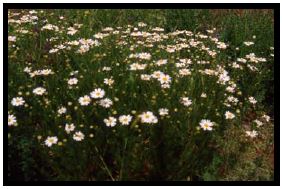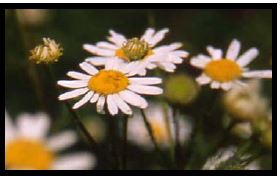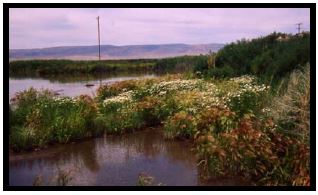INTRODUCTION
Corn or scentless chamomile (Anthemis arvensis L.) is an annual flowering plant (forb) native to much of Europe, parts of Northern Africa, and Asia. It has become naturalized in North America, southern Africa, Australia, and New Zealand. By 1995, it had been found in 37 of the lower 48 states, including the adjacent states of California, Oregon, and Idaho. In northern Nevada it can be found in the Quinn River Valley, near Orovada, and possibly other locations.
Scentless chamomile has been listed as a noxious weed in Colorado, and is a very close relative to mayweed chamomile or dog fennel (Anthemis cotula L.), also known as stinking mayweed and dog fennel. Mayweed chamomile is a serious problem weed in grain and forage crops throughout the United States, and also may interfere with crop harvest. Because of many similarities (size, shape, phenology, etc.) between scentless chamomile and mayweed chamomile, scentless chamomile has the potential to become a serious problem weed in agricultural areas throughout Nevada. It has no known economic uses and may adversely affect (taint) milk if consumed by dairy cattle.
TAXONOMY
Seedling
At the seedling stage, the cotyledons (first two leaf-like structures) have an elliptical to egg shape with rounded tips. These leaves are attached directly to the stem (i.e., they lack a stem or petiole). The first true leaves are pinnate; that is, they have leaflets on both sides of the stem.
Adult Plant:
Mature scentless chamomile (Figures 1 and 2) are usually between 6 and 20 inches tall. The stems are often branched and have sparse hairs. The leaves are about 1 to 2 inches long. They occur in an alternate pattern along the branches, have few hairs, and are divided into many threadlike segments. They are not linear (line like). The flowers have white edges, with a central yellow flower. They are about 0.75 to 1.25 inches in diameter. Common plants that scentless chamomile is confused with are tall chamomile (Anthemis altissima), mayweed chamomile or dog fennel, dusky dog fennel (Chamaemelum fuscatum), weedy dog fennel (Chamaemelum mixtum), and whitebuttoms (Anacylus clavatus).
Figure 1. Mature scentless chamomile plant.

Figure 2. Scentless chamomile flowers

PLANT GROWTH AND DEVELOPMENT
In both Great Britain and the northeastern United States, scentless chamomile has two periods of peak germination: autumn and spring. If moisture is provided, seed germination is possible throughout the year. In Nevada, this species appears restricted to irrigated fields, storage ponds, and irrigation ditches. Irrigation in many locations is finished by early to mid September and fields dry rapidly. Fall germination and overwintering appear to be uncommon. All plants observed in the Orovada area begin growth in the spring.
Spring germination largely occurs from March through May, with rapid plant growth in June. Flowering may begin in May and continue into the fall until the first frost. The first frost kills mature plants.
SPECIES ECOLOGY
Soils and Climate
In Britain scentless chamomile prefers light, well drained calcareous or sandy soil. Similar type soils are common in agricultural fields near Orovada. Soil pH can range from less than 6 to almost 8. Scentless chamomile has been found above 3,300 ft in California, and over 6,200 ft in England. In England, scentless chamomile typically occurs in areas with less than 35 inches of precipitation and mean summer temperatures around 62°F. The average June and July temperatures in Orovada are 63°F and 71°F, respectively. These conditions are similar to irrigated agricultural fields in many valleys of northern Nevada.
Scentless chamomile is cold tolerant. It has grown as a winter annual in the northeastern United States. It may germinate in the fall, over winter in a rosette form, and continue growth in the spring. Fall germination appears unlikely in Nevada due to the lack of fall precipitation in most years. Also, most irrigation has ended by fall. Spring germination is common due to both rainfall and irrigation. Seed has been known to germinate year-round if moisture is available and temperatures are not too cold. Scentless chamomile is more drought tolerant than the other mayweed species, which suggests it has potential to spread to subirrigated meadows throughout Nevada.
Scentless chamomile can grow well in low nitrogen (14 ppm) and low phosphorus (0.31 ppm) environments common on sandy soil. It can compete effectively with barley on low nitrogen environments.
Seed Production, Dispersal, and Viability
Reproduction of scentless chamomile is entirely from seed, and seed production can be quite large. Research has recorded over 300 seed capsules per plant, although 35 to 70 are more typical. Average size plants commonly produce 2,000 to 4,000 seeds per plant. There are no physical adaptations for dispersal. Dispersal over short distances is primarily from wind. Dispersal over moderate distances appears related to the movement in irrigation water through delivery systems, and possibly attachment to farm equipment or animals. Seed has been found to survive passage through the digestive system of pigeons; thus, birds could transport seed over long distances. Long distance dispersal occurs when seed is captured in forage and seed crops during harvest, and transported to another area for use.
The seed of scentless chamomile can remain alive for many years. Researchers found 91% germination in soil-stored seed after 3 years, and 47% germination after 11 years. Seed germination appears to increase substantially after the seed has been in the soil for a 4 to 10 month period. Also, one study found germination increased from 8% to 100% after passage through the digestive tract of pigeons. Scentless chamomile seed has a tough seed coat that must be softened before germination can occur. Soil microorganisms, faunal digestive systems, and perhaps freeze thaw cycles, remove the seed coat.
GROWING LOCATIONS
In the Orovada area, dense stands of scentless chamomile have been found along the edges of roads and irrigated fields, and along irrigation ditches and tailwater ponds (Figure 3). Widely scattered plants have been observed in alfalfa seed, alfalfa hay, and grain crops. These are common locations for the plant in Great Britain, although it often has a high abundance in cereal crops.
Figure 3. Typical habitat conditions for scentless chamomile at Orovada. White flowered plants are scentless chamomile.

CONTROL
Once scentless chamomile has established and produced seed at least once, eradication is almost impossible. The seed can live in the soil for more than 10 years and have about 50% viability. Given the high seed production per plant, this results in a large number of live seeds for many years after treatment begins. Control of the plant is a more realistic goal than eradication. Several control methods are possible and can be used in conjunction with one another.
Numerous herbicides have been tested and found to effectively control mayweeds, including scentless chamomile. These include: Roundup Pro, Telar, Tordon, Transline, Escort, Velpar, and Oracle (a dicamba product). Other herbicides may also be effective, but have not been tested specifically on scentless chamomile or the closely related mayweeds. Scentless chamomile is resistant to 2,4- D and other phenoxyacetic acid herbicides. If repeated herbicide applications are used, the applicator should alternate between chemicals to reduce the possibility of developing herbicide resistance.
Each herbicide known to control scentless chamomile has very specific instructions on the product label. Some herbicides cannot be applied to each of the specific growing conditions in which scentless chamomile occurs (e.g., along irrigation ditches). The specific conditions under which each herbicide should be can be found on the product label. These labels can be accessed on the internet (Table 1).
Once herbicides reduce the density of large infestations, removal of remaining plants is feasible by mowing, hoeing, hand pulling, disking, or other methods. Scentless chamomile is an annual plant that reproduces only from seed. Removing the flowers before seed is set effectively eliminates future plants. Small infestations can be controlled easily by mowing or cutting the plants prior to seed set.
Treated areas that lack desirable, competitive vegetation are susceptible to reinfestation. The area should be seeded to and managed for an acceptable species, to competitively exclude scentless chamomile and other weeds.
If scentless chamomile occurs on cropland and has viable seed when machinery is used in the field, the equipment should be washed afterwards. . This will reduce the chance of seed being moved from one area to another.
Biological control has been researched in Canada but has not been found to control the plant by itself. The biological agent is a seed-head weevil (Omphalaplon hookeri). Research has found this species attacks up to 70% of the seed-heads, but over 170 seeds/head can still be produced, with 55% viability of the seed.
BIBLIOGRAPHY
Bowes, G. B. 1999. Scentless Chamomile Control on Roadsides. The Rural Councillor 34(10):1-4.
Harris, P. and A. McClay. 2001. Omphalapion hookeri Kirby. Seed-head weevil. Lethbridge Research Centre, Alberta, Canada. 3 pp.
Kay, Q. O. N. 1971. Bilolgical Flora of the British Isles. Anthemis arvensis L. Journal of Ecology 59:637-648.
USDA Natural Resources Conservation Service. 2002. Plants Profile. Anthemis arvensis L. Corn Chamomile The PLANTS database. National Plant Data Center, Baton Rouge, LA. 708774
USDA Agricultural Research Service. 2002. Germplasm Resources Information Network National Plant Germplasm System.
Davison, J. and Schultz, B.
2002,
Scentless Chamomile: Taxonomy, Ecology, and Control,
Extension | University of Nevada, Reno, FS-02-85


